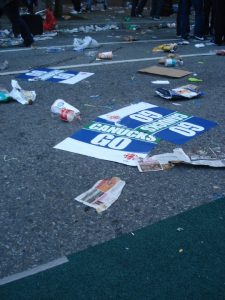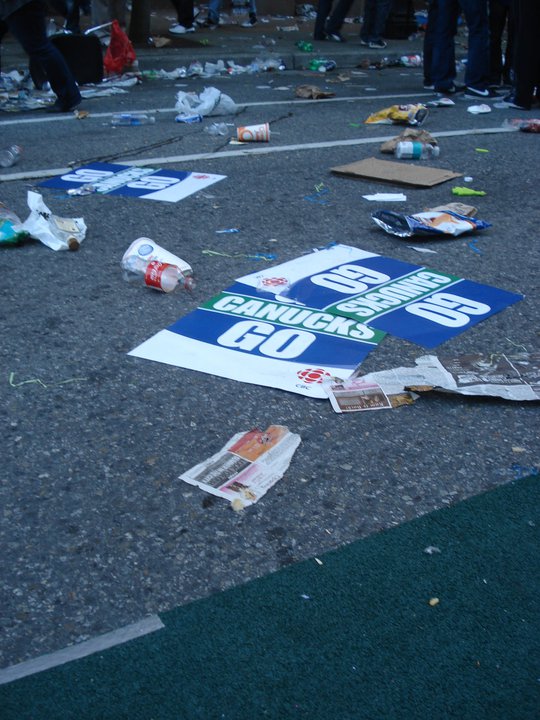Date Posted: June 28, 2011
Print Edition: June 24, 2011
By Karen Aney (The Cascade) – Email
 We didn’t think it could happen again. The riot in 1994 was unexpected, terrible, and a black mark on the city of Vancouver. Well, it seems that the 17 year break has given Vancouver time to grow. By all accounts, this time was worse – but why?
We didn’t think it could happen again. The riot in 1994 was unexpected, terrible, and a black mark on the city of Vancouver. Well, it seems that the 17 year break has given Vancouver time to grow. By all accounts, this time was worse – but why?
Some claim the police were not prepared to deal with it properly, but as Vancouver Police Chief Jim Chu explained in a statement, the riot was ceased within three hours. Not long compared to the full six hours it took police forces in ‘94. However, the damage done 17 years ago totalled approximately $1-million dollars. The damage so far for this riot has not been assessed – but to put it in perspective, London Drugs alone has estimated their loss to be at $1.3-million. So, better police, worse fans? Not according to the plethora of Linden jerseys in the crowd. We’re a die-hard bunch.
The first thing to note is that the trouble started before the game was done. Would-be rioters wearing hoods, carrying backpacks, and sporting bandanas were spotted on the streets before the third period even ended. As Chu explained: “A number of young men and women disguised as Canucks fans… were actually criminals and anarchists. These people came equipped with masks, goggles, and gasoline, even fire extinguishers which they then used as weapons.” Further, he stated that many of these individuals are known to police, some from having taken part in the vandalism during the Winter Olympics.
The organized nature of the violence becomes clear when analyzing the tactical manner of the attacks. For example, the initial point of vandalism was the flipped truck in the parking lot of the post office on Georgia Street. This was the epicentre of the live viewing party, with three screens within a one square block radius. There were thousands of fans concentrated in this area, and hundreds more streaming past on their way to Stadium Skytrain station. Before the entirety of these crowds could converge around the burning vehicle, the hooded individuals had moved west, leaving destruction in their wake. The extent of this destruction (at the post office, the BMO, and surrounding businesses) was such that masses of curious people congregated in these areas, leaving large crowds for the VPD to disperse. This drove part of the crowd further west, and many collected on Granville, while the majority of the police were still attempting to disperse the crowds in other areas. By the time they were done, the downtown core had a startling and eerie resemblance to a post-apocalyptic horror film.
One question the VPD has refused to answer is why they chose to disperse crowds in the directions they did. The first row of shielded police came south on Georgia, beginning just past Homer – towards the businesses and away from industrial development. This pattern seems to have been followed in other areas, but why? Chu stated that tactical methods were recommended by those who study riots across the world, but this does not explain why the crowd was driven towards the businesses – or at least, why the first wave of police pushed in the direction of the core, rather than away from rich looting opportunities.
While thousands of fans remained downtown, it was a small group inciting the violence. Walking down Granville Street after the worst of the riot had been diffused, this became evident: while police were focusing on directing bystanders away from flaming vehicles and dangerously damaged buildings, some took the opportunity to loot items from stores with windows already broken. One young woman, noticing a looter, screamed: “I’m ashamed to live in the same city as you!” This attracted the attention of a police officer, who proceeded to arrest the young man who was stealing shoes from Sterling on Granville. There were a number of civilians who ran up and down the streets, brandishing fire extinguishers, putting out burning mannequins and blocking would-be looters from entering broken storefronts.
Perhaps one of the most frustrating parts of the experience downtown was the lack of consistency between officials. For instance, one officer stated that Dunsmuir was closed from public access because of a fire. Less than fifteen minutes later, a member of the transit police demanded we take that route to Stadium SkyTrain station. Unilateral knowledge is perhaps impossible, but in today’s world with its advanced technologies, it should be possible to keep those in positions of enforcement aware of dangerous areas. If the authorities were more consistently aware of the situations in multiple areas of the downtown core, perhaps some of the damage done that night could have been avoided – hooded anarchists on the loose or not.


